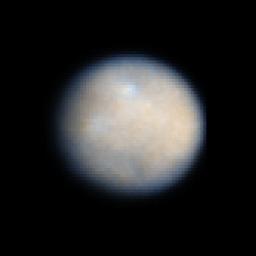
|
Color View of Ceres
- Click the image above for a larger view
- Full-Res JPEG (250 x 250) (3.8 kB)
- Full-Res TIFF (250 x 250) (187.9 kB)
Caption:
This is a NASA Hubble Space Telescope color image of Ceres, the largest object in the asteroid belt.
Astronomers enhanced the sharpness in these Advanced Camera for Surveys images to bring out features on Ceres' surface, including brighter and darker regions that could be asteroid impact features. The observations were made in visible and ultraviolet light between December 2003 and January 2004.
The colors represent the differences between relatively red and blue regions. These differences may simply be due to variation on the surface among different types of material.
Ceres' round shape suggests that its interior is layered like those of terrestrial planets such as Earth. Ceres may have a rocky inner core, an icy mantle, and a thin, dusty outer crust inferred from its density and rotation rate of 9 hours. Ceres is approximately 590 miles (950 kilometers) across and was first discovered in 1801.
Cataloging Keywords:
| Name | Value | Additional Values |
|---|---|---|
| Target | 1 Ceres | |
| System | Main Belt | |
| Target Type | Dwarf Planet | Asteroid |
| Mission | Hubble Space Telescope (HST) | |
| Instrument Host | Hubble Space Telescope | |
| Host Type | Space Telescope | |
| Instrument | Advanced Camera for Surveys (ACS) | |
| Detector | ||
| Extra Keywords | Color, Dust, Impact, Rotation, Ultraviolet, Visual | |
| Acquisition Date | ||
| Release Date | 2005-09-07 | |
| Date in Caption | ||
| Image Credit | NASA/ESA/J. Parker (Southwest Research Institute), P. Thomas (Cornell University), L. McFadden (University of Maryland, College Park), and M. Mutchler and Z. Levay (STScI) | |
| Source | photojournal.jpl.nasa.gov/catalog/PIA10235 | |
| Identifier | PIA10235 | |
